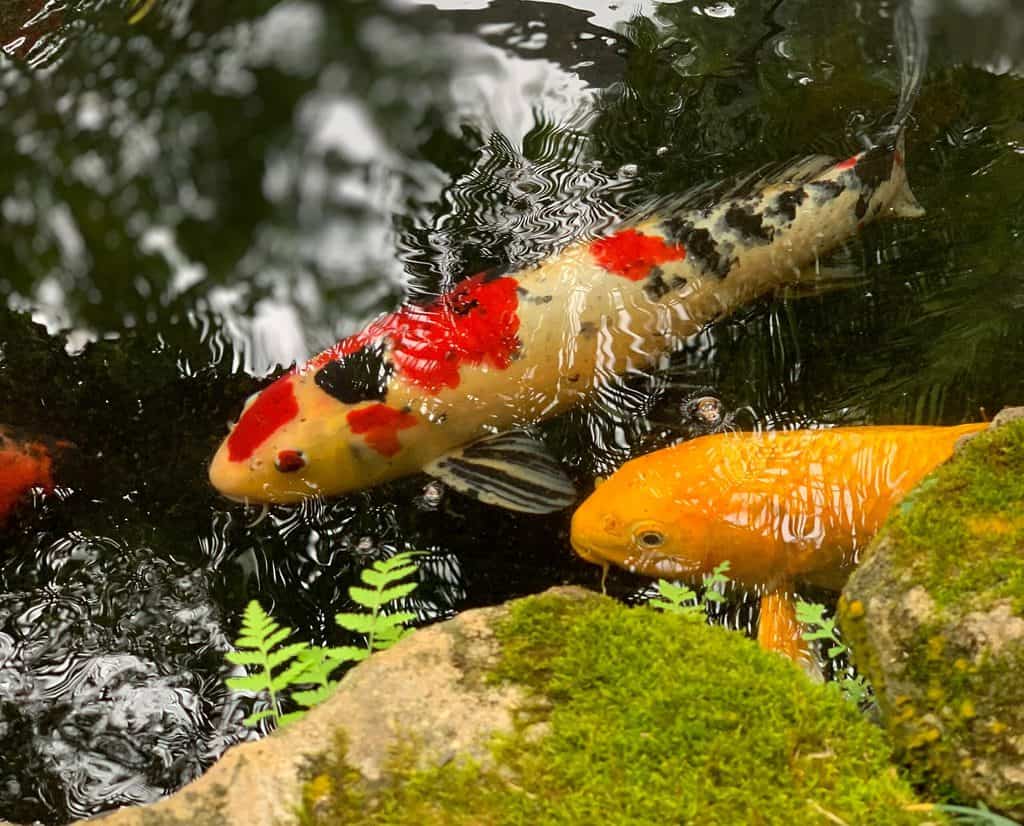Every backyard pond that you have ever seen is a functioning ecosystem. Just as all plants and animals out of the water are part of the natural ecosystem, all of the life below the water is also part of its own little ecosystem. An ecosystem is a dynamic, functional unit comprised of consumers, producers, and decomposers. One portion could not survive without the other, so the well-being of the whole will be reflected in the individual’s well-being.
Garden ponds were rare not so long ago. They are now considered to be an essential part of many backyard gardens. They genuinely transform a backyard, no matter the size of the pond. Dragonflies, fish, frogs, and lovely plants are all part of the beauty that comes with a backyard pond. It can be as grand or as simple as you would like.
The addition of a waterfall to the pond will create a beautiful visual and auditory display. It will also help improve the pond ecosystem by providing vital water movement and oxygen. You will also find that living creatures such as frogs, snakes, birds, turtles, rabbits, mice, chipmunks, and squirrels will all appreciate having a fresh water source nearby.
A backyard pond will include the following:
Rubber Pond Liner
Most small backyard ecosystem ponds are lined. Pond liner is used to retain water in a garden pond, stream, and waterfall. 45 mil, EPDM Rubber the most common pond liner used because of its flexibility to conform to any shape and durability to withstand many years of service. The rubber liner is laid into a previously excavated hole, and the edges of the rubber are tucked in or hidden above the pond’s high water line.
I would always recommend installing underlayment under the rubber to help protect it from sharp sticks and stones. Underlayment is cheap; rubber is not. EPDM pond liner will last indefinitely if protected from the elements. Sunlight is the most destructive force for rubber, so protecting the liner from the sun by covering it with rocks, gravel, and plants is your best bet.
Piping for Your Pond
I would always recommend using flexible PVC piping as it is easy to work with, it can be bent to create curves, and it is reasonably resilient to the freeze and thaw that occurs in many climates. The pipe must be back-pitched to allow for the water to drain out when the pump is off to avoid freezing when full of water.
Pump
You will need a pump to move the water in your pond; stagnant water does not make for a thriving ecosystem. Your pump should be chosen based on efficiency and desired water flow. This site has much good information on pond construction. They say you should select a pump capable of turning over the pond water volume once each hour.
Filtration
Having a wetland filtration system for your pond will allow the water to be filtered, the suspended solids to settle out, and help remove toxins and nutrients from the pond water, which will help create a healthy pond ecosystem. There are hundreds of man-made filter boxes and systems on the market, but they all pale in comparison to the wetland filter and, for the most part, are not worth the money.
So How Does a Backyard Pond Ecosystem Work?
As we mentioned, the pond ecosystem is made up of producers, consumers, and decomposers. Let’s talk a bit about each of these groups and what they do for our backyard pond ecosystem.
The Producers
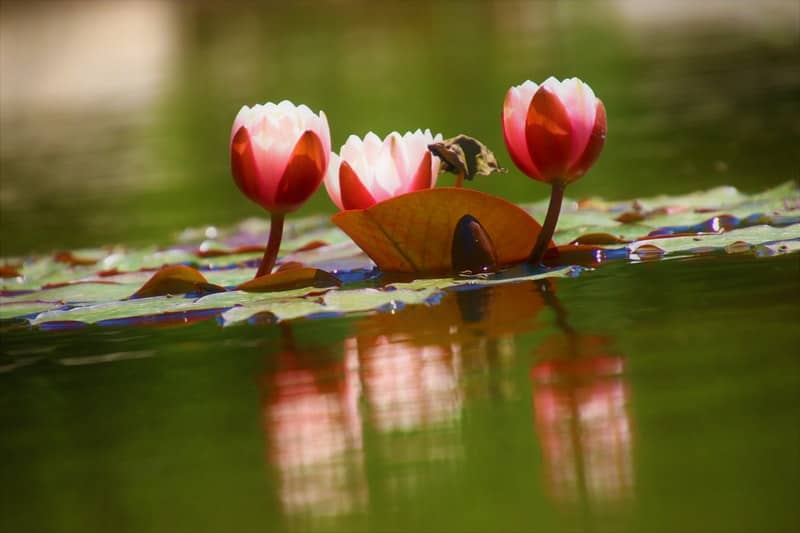
The biggest producers in our backyard pond ecosystem are the plants. Just like plants play the most critical role in our above water ecosystem, they also play the most important role in your backyard pond ecosystem. They collect their energy from the sun and use photosynthesis to convert carbon dioxide and water to organic compounds and oxygen. These plants, in turn, require phosphorous and nutrients to survive.
While algae aren’t technically classified as a plant because it doesn’t have stems and leaves, it is a plant-like organism that carries on the process of photosynthesis. In fact, there have been some scientists who estimate that algae produce half of the earth’s oxygen. So, the next time that you see algae bloom in your pond, you can smile, knowing that your pond is helping to oxygenate our earth.
The main reason that you are getting these algae blooms in your pond is because of nutrient pollution. Nutrient pollution is typically caused by fertilization, runoff, and animal wastes. When we get an algae bloom, we should look in the mirror for the cause because it is us more often than not. People often think that algae blooms are bad. The reality is that they are likely just a symptom of something that humans have done to offset nature’s balance. With backyard ponds, lawn fertilizers are often the worst culprits.
The pretty aquatic plants and the algae in our ponds compete for the same nutrients. The most effective way to control algae growth in your backyard pond and maintain clear, healthy pond water is to incorporate many plants into the pond. More plants taking in nutrients means that there will be fewer nutrients available for algae.
Some plants are more effective than others at removing nutrients from a pond. An effective wetland filter filled with plants will help maintain good water quality by eliminating harmful ammonia from fish waste and decaying plants and allowing all of those plant roots to soak up the nutrients from your water.
These ultra-effective plants are known as “clear water plants” because they will beat the algae to the water’s nutrients. These are fast-growing plants with high metabolic rates and extensive root systems to absorb nutrients. This makes them really good at soaking up phosphorous and nitrogen.
Here are some of these “clear water” plants.
- Oxygenating Pond Plants
These plants, such as hornwort and water thyme, are incredibly effective clear water plants because they feed through their roots and foliage. One bunch should be used for every three-square foot surface area of the pond for the best result. They also provide spawning areas for fish and provide shelter for baby fish. - Floating Pond Plants
Water lettuce and water hyacinth are beneficial as filter plants because they are fast growers and heavy feeders. They will multiply quickly and take in many nutrients right up until the first frost when they will wilt and die. They block the sun and shade the pond competing with algae for nutrients. Like submerged plants, their root structure provides spawning areas for fish and shelter for babies. Duckweed, ivy duckweed, fairy moss, and floating fern are also effective clean water plants. - Variegated Water Celery
Variegated water celery is a good, low-growing filter plant. If planted in a shallow gravel bed or a mesh planting basket, these plants thrive, producing thick roots. The variegated foliage is attractive in the spring when it has pink fringes. - Water Iris
Water iris have beautiful flowers and stunning sword-like foliage. They are also very efficient filter plants. Like other marginal plants, they are best planted in shallow gravel beds or mesh baskets to spread their fibrous roots. - Watercress
Watercress is a very vigorous plant with delicate white flowers. When the warm weather arrives, this low-growing plant will grow extremely fast, producing long white roots that are very efficient at sucking up nutrients from the water. Watercress prefers to grow in flowing water, making it perfect for streams and waterfalls. It is also suitable for your salad! - Pickerel Plant
Having beautiful pink or blue flowers, pickerel plants are functional, clear water plants while also being decorative. - Taro
Taro are tropical plants that produce huge leaves, some having beautiful patterns and colors. The “Black Magic” variety is a popular variety that has very dark purple, almost black, stems, and leaves. When the water gets warm, these are amazingly fast-growing, but if you are in the colder climates, the plants will die at the first sign of frost. - Water Lilies
Water lilies are not considered filter plants, but they shade the water, which inhibits algae growth and keeps the pond water cooler. A well-thought-out garden pond should be 60-70% covered with plants. Water lilies are always a pond favorite as they can bloom all summer and come in a wide array of colors.
Caution
Be aware that many fast-growing aquatic plants are considered invasive, so check your state’s invasive plants list and be sure to keep these pond plants in the pond where they belong. Fast-growing plants in the pond are great for absorbing nutrients, but they can quickly take over garden beds out of the pond.
Consumers

The consumers in your backyard pond ecosystem are all of the creepers, crawlers, and swimmers in your water. There are tiny little microscopic zooplankton; there are small little invertebrates (water beetles, snails, worms, pond skaters, etc.) and the larger vertebrates (fish, frogs, snakes, etc.). All of these consumers swim around-consuming each other as well as feeding on the plants and algae in our ponds.
Decomposers
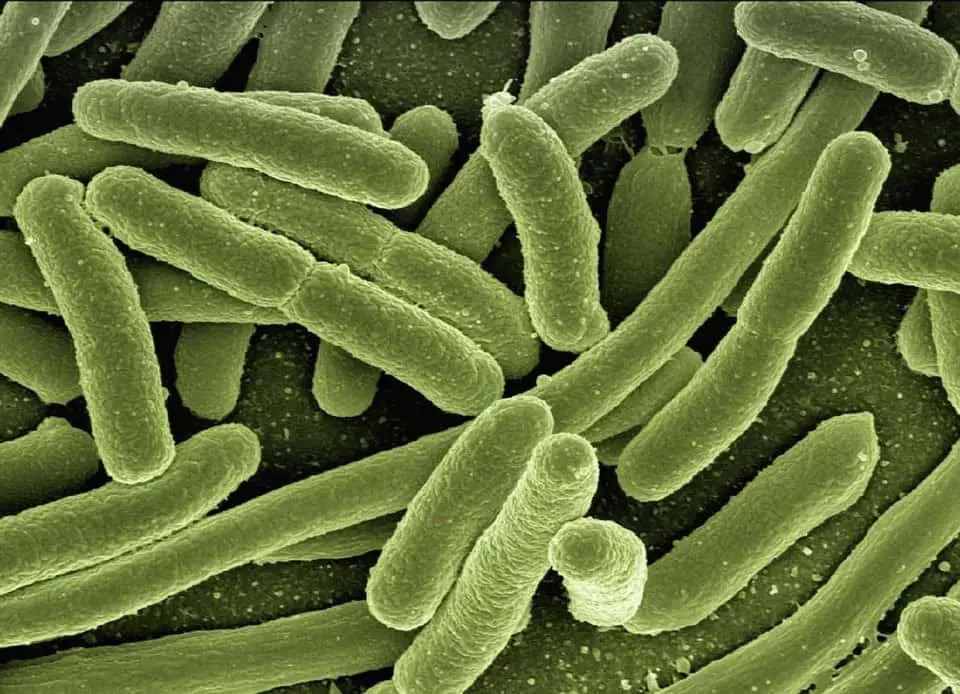
The bacteria and enzymes in your backyard pond ecosystem are the base for the animal food chain. Bacteria and enzymes decompose and consume any waste material from plants or animals that end up in your pond. Bacteria also become a food source for the consumers in your pond, which may, in turn, become food for the larger animals that come to your pond. All of these living organisms compete for the nutrients in your pond. The more nutrients that get taken up by these pond organisms, the less there is available for algae.
There are aerobic and anaerobic bacteria, each serving their own purpose in your pond, breaking down organic matter. Healthy quantities of bacteria and adequate oxygen levels will reduce the muck (organic sediment) on the pond bottom. This muck layer on the bottom of your pond can be thought of as fertilizer as it contains phosphorous and nitrogen, both of which contribute to algae growth.
Removing this muck using natural bacteria products will improve water clarity and reduce the amount of phosphorus and nitrogen available to grow algae. If you spend time in your pond, you will appreciate the lack of slimy muck on the pond’s bottom.
Enzymes are required for life on earth. Just like we can’t exist without oxygen or water, we can’t exist without enzymes. Enzymes are organic proteins that are made from amino acids. In nature, enzymes control the build-up and decomposition of necessary matter in animal organisms and vegetation.
All of this decomposition and breakdown being caused by the bacteria and enzymes won’t happen (or will at least be slowed dramatically) without oxygen. In eutrophic or aging ponds where aquatic plants and algae are a problem, there is usually too much organic waste and insufficient oxygen.
This is why water flow is so essential to a pond. The more water flow we give our ponds through waterfalls and bottom aeration, the more oxygen is present, and the more effective the bacteria and enzymes can be in breaking down the organic muck.
Here is The Ecosystem Circle
To summarize: Plants take in nutrients and give off oxygen, bacteria decomposes and consumes organic muck. Fish, water bugs, etc., eat whatever is smaller than them, including plants, and all waste and decomposing debris creates nutrients to feed the plants. There it is, one big circle!
Here is How We Humans Screw Up the Ecosystem
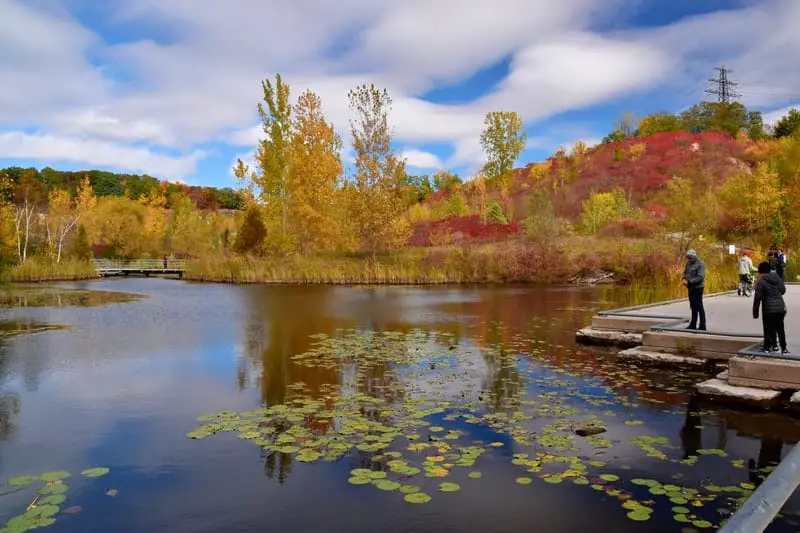
This circle of life can be easily disrupted. The typical, uneducated(on pond life) homeowner means well and wants a nice-looking pond, so they go to the local hardware store or search online for algae killer and find a hazardous chemical that will kill the algae. This product is touted as fish safe, so they think it is okay. Fish safe means that it shouldn’t kill your fish unless you apply too much. Sort of how radiation is “human safe.”
In reality, any of these man-made chemicals are hazardous and deadly to life in your pond. They may not kill the fish, but they do kill much of the other life and bacteria in your pond, along with the algae.
The homeowner dumps it in their pond, keeps their fingers crossed, and sure enough, the fish lived, and the algae died. They are happy, but they don’t realize that they just created a biological nightmare.
The chemicals killed much of the pond’s beneficial life, and the dead algae sank to the bottom. Now they have a layer of dead algae on top of a dead bunch of muck that has lower bacteria levels because of the chemicals. The algae layer now begins to rot slowly and robs the muck of whatever oxygen there was at the pond bottom. As it decomposes, the algae gives off nutrients which create a rich environment to feed the next algae bloom as soon as the chemicals wear off.
One week or so later, the homeowner is back buying more chemicals to start this process all over again.
We need to have patience, step back, and let our pond ecosystem take care of itself. Add beneficial bacteria, add more plants to the pond and wait for it to balance. Once in balance, your pond will take care of itself. That is what this ecosystem is all about.
Also, be aware that many companies out there are creating new gadgets every year that claim to help your pond. Chemicals, chemical injectors, ionizers, UV-sterilizers, sand filters, etc., are all products that are designed to empty your pocketbook but will not help your pond ecosystem. Only mother nature can do that!
Aquatic Wildlife
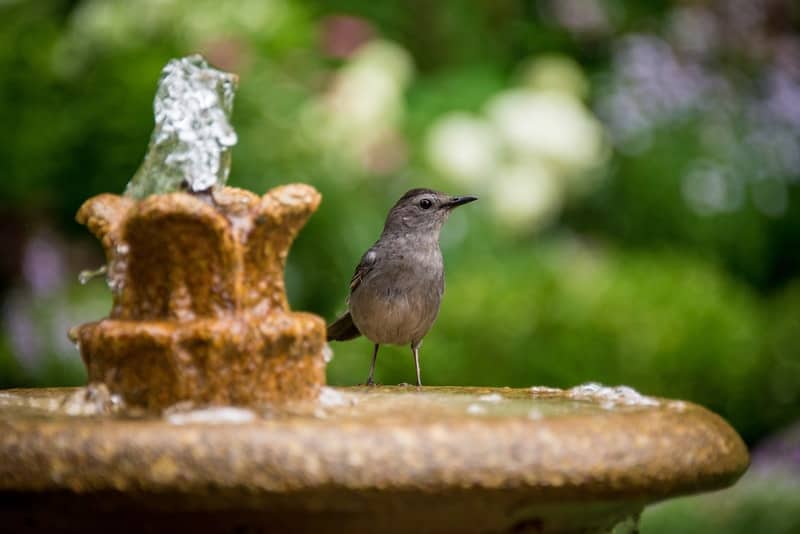
Garden ponds add beauty and visual interest to a backyard landscape, but they can also benefit wildlife as a habitat. Ponds offer food sources, clean water for drinking or living, shelter, and nesting sites or materials for many types of wildlife, including butterflies and birds.
We, in turn, benefit from the ecosystem provided by the pond, with more mosquito-eating dragonflies and cleaner, oxygenated air.
Gradually sloping edges or ledges with short vertical drops on the edge of the pond will help many smaller birds, insects, and amphibians get in and out of the pond with ease or enable them to access the water for bathing or drinking.
Here are some things to consider that will benefit and attract wildlife to your backyard garden pond.
- Moving water – the sound attracts wildlife and reduces breeding mosquitoes.
- Perches and shelters provide areas for wildlife to rest, find food, offer nesting areas, or hide from the elements and predators. Pale-colored rocks can reflect the sun to warm dragonflies’ bodies and other insects.
- Sun and shade – if possible, locate your pond so it receives both some sun and some shade part of the day. You will attract a wider variety of wildlife.
- Significant water depth will prevent the pond from freezing all the way through during the winter. I would recommend a minimum of three feet deep. This is advantageous, so aquatic wildlife and plants can survive the winter. Aquatic wildlife can also hide from predators in deeper sections of the pond. It’s hard, but remember that predators need to live too. Losing some fish to predators only means that your pond is an active part of the larger ecosystem.
- Avoid invasive animals or plants in your backyard pond. A seed, root, stem, or leaf, pest, or disease can spread at random, even into the containers of non-invasive aquatic plantings. Some invasive plants to avoid are:
- Flowering rush
- Brazilian elodea
- Yellow flag iris
- Eurasian watermilfoil
- Plant a native garden close to your pond that will attract a diversity of wildlife to your yard, which will then find and use your new wildlife pond.
- NEVER spray pesticides, herbicides, or insecticides near your pond or anywhere on your property. Our ecosystem depends on you to do your part to take care of it.
Conclusion
With a bit of patience and knowledge, we can easily have a beautiful, low-maintenance backyard pond with a fully functioning and balanced ecosystem. This pond will enliven your yard for the rest of your life and will benefit the lives of any animal that is lucky enough to live near it. Just have patience and let mother nature do the heavy lifting.

